Sung-Eui Yoon
Efficient Navigation Among Movable Obstacles using a Mobile Manipulator via Hierarchical Policy Learning
Jun 18, 2025Abstract:We propose a hierarchical reinforcement learning (HRL) framework for efficient Navigation Among Movable Obstacles (NAMO) using a mobile manipulator. Our approach combines interaction-based obstacle property estimation with structured pushing strategies, facilitating the dynamic manipulation of unforeseen obstacles while adhering to a pre-planned global path. The high-level policy generates pushing commands that consider environmental constraints and path-tracking objectives, while the low-level policy precisely and stably executes these commands through coordinated whole-body movements. Comprehensive simulation-based experiments demonstrate improvements in performing NAMO tasks, including higher success rates, shortened traversed path length, and reduced goal-reaching times, compared to baselines. Additionally, ablation studies assess the efficacy of each component, while a qualitative analysis further validates the accuracy and reliability of the real-time obstacle property estimation.
LangPert: Detecting and Handling Task-level Perturbations for Robust Object Rearrangement
Apr 14, 2025Abstract:Task execution for object rearrangement could be challenged by Task-Level Perturbations (TLP), i.e., unexpected object additions, removals, and displacements that can disrupt underlying visual policies and fundamentally compromise task feasibility and progress. To address these challenges, we present LangPert, a language-based framework designed to detect and mitigate TLP situations in tabletop rearrangement tasks. LangPert integrates a Visual Language Model (VLM) to comprehensively monitor policy's skill execution and environmental TLP, while leveraging the Hierarchical Chain-of-Thought (HCoT) reasoning mechanism to enhance the Large Language Model (LLM)'s contextual understanding and generate adaptive, corrective skill-execution plans. Our experimental results demonstrate that LangPert handles diverse TLP situations more effectively than baseline methods, achieving higher task completion rates, improved execution efficiency, and potential generalization to unseen scenarios.
Denoising Nearest Neighbor Graph via Continuous CRF for Visual Re-ranking without Fine-tuning
Dec 18, 2024



Abstract:Visual re-ranking using Nearest Neighbor graph~(NN graph) has been adapted to yield high retrieval accuracy, since it is beneficial to exploring an high-dimensional manifold and applicable without additional fine-tuning. The quality of visual re-ranking using NN graph, however, is limited to that of connectivity, i.e., edges of the NN graph. Some edges can be misconnected with negative images. This is known as a noisy edge problem, resulting in a degradation of the retrieval quality. To address this, we propose a complementary denoising method based on Continuous Conditional Random Field (C-CRF) that uses a statistical distance of our similarity-based distribution. This method employs the concept of cliques to make the process computationally feasible. We demonstrate the complementarity of our method through its application to three visual re-ranking methods, observing quality boosts in landmark retrieval and person re-identification (re-ID).
Regularizing Dynamic Radiance Fields with Kinematic Fields
Jul 19, 2024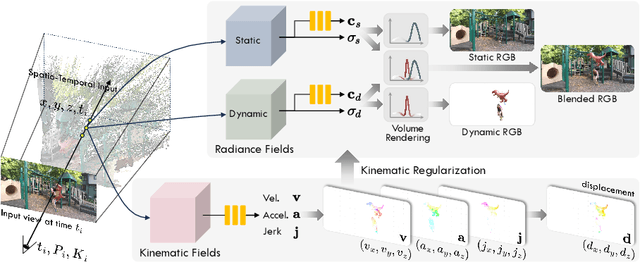
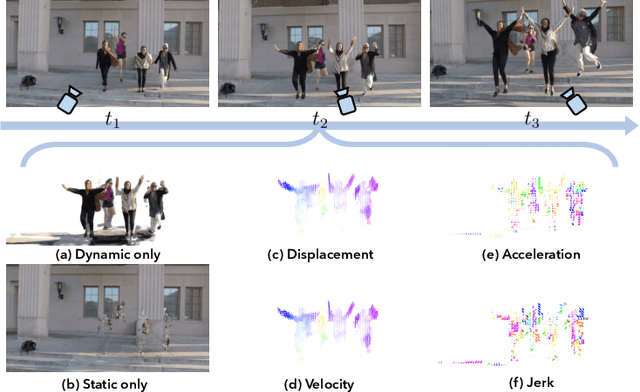


Abstract:This paper presents a novel approach for reconstructing dynamic radiance fields from monocular videos. We integrate kinematics with dynamic radiance fields, bridging the gap between the sparse nature of monocular videos and the real-world physics. Our method introduces the kinematic field, capturing motion through kinematic quantities: velocity, acceleration, and jerk. The kinematic field is jointly learned with the dynamic radiance field by minimizing the photometric loss without motion ground truth. We further augment our method with physics-driven regularizers grounded in kinematics. We propose physics-driven regularizers that ensure the physical validity of predicted kinematic quantities, including advective acceleration and jerk. Additionally, we control the motion trajectory based on rigidity equations formed with the predicted kinematic quantities. In experiments, our method outperforms the state-of-the-arts by capturing physical motion patterns within challenging real-world monocular videos.
OpenSlot: Mixed Open-set Recognition with Object-centric Learning
Jul 02, 2024



Abstract:Existing open-set recognition (OSR) studies typically assume that each image contains only one class label, and the unknown test set (negative) has a disjoint label space from the known test set (positive), a scenario termed full-label shift. This paper introduces the mixed OSR problem, where test images contain multiple class semantics, with known and unknown classes co-occurring in negatives, leading to a more challenging super-label shift. Addressing the mixed OSR requires classification models to accurately distinguish different class semantics within images and measure their "knowness". In this study, we propose the OpenSlot framework, built upon object-centric learning. OpenSlot utilizes slot features to represent diverse class semantics and produce class predictions. Through our proposed anti-noise-slot (ANS) technique, we mitigate the impact of noise (invalid and background) slots during classification training, effectively addressing the semantic misalignment between class predictions and the ground truth. We conduct extensive experiments with OpenSlot on mixed & conventional OSR benchmarks. Without elaborate designs, OpenSlot not only exceeds existing OSR studies in detecting super-label shifts across single & multi-label mixed OSR tasks but also achieves state-of-the-art performance on conventional benchmarks. Remarkably, our method can localize class objects without using bounding boxes during training. The competitive performance in open-set object detection demonstrates OpenSlot's ability to explicitly explain label shifts and benefits in computational efficiency and generalization.
Fine-grained Background Representation for Weakly Supervised Semantic Segmentation
Jun 22, 2024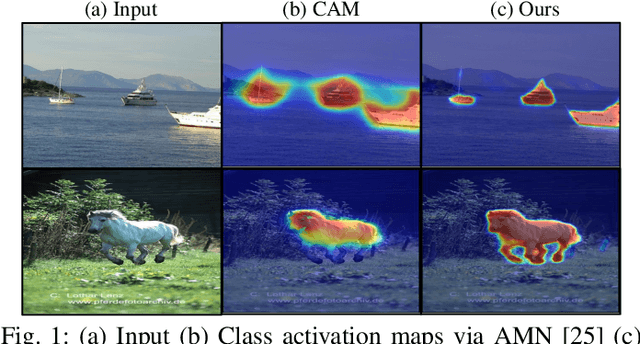
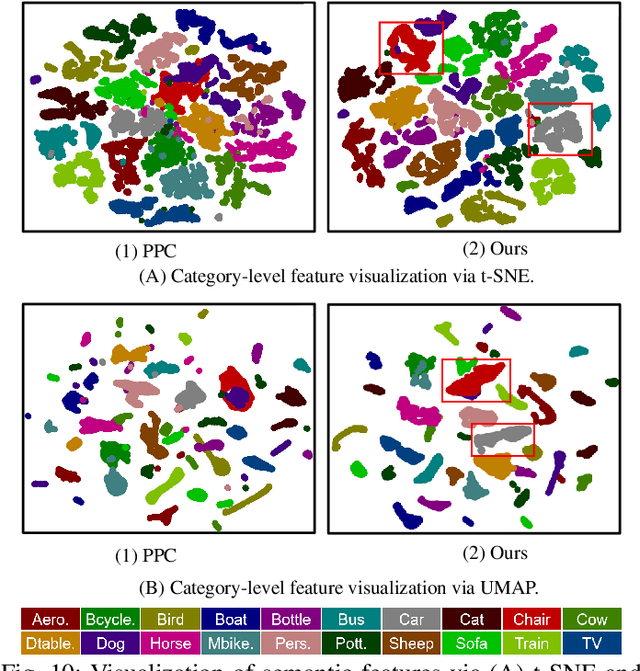
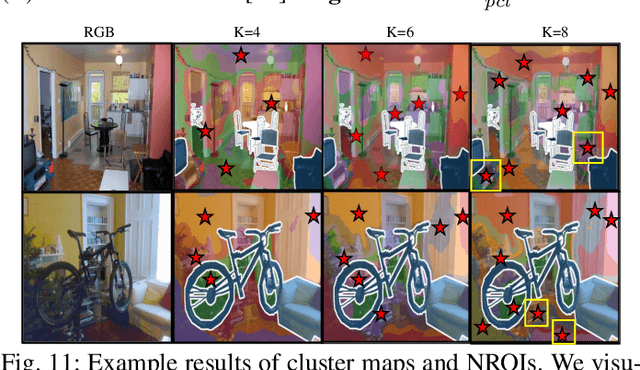
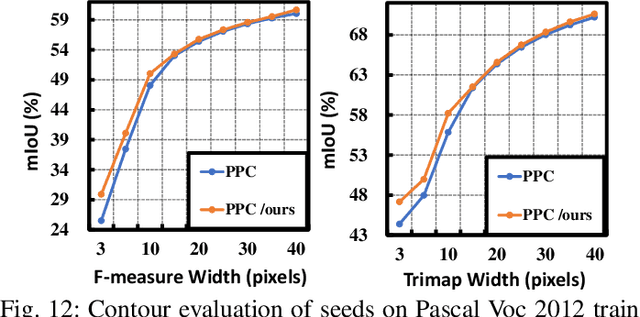
Abstract:Generating reliable pseudo masks from image-level labels is challenging in the weakly supervised semantic segmentation (WSSS) task due to the lack of spatial information. Prevalent class activation map (CAM)-based solutions are challenged to discriminate the foreground (FG) objects from the suspicious background (BG) pixels (a.k.a. co-occurring) and learn the integral object regions. This paper proposes a simple fine-grained background representation (FBR) method to discover and represent diverse BG semantics and address the co-occurring problems. We abandon using the class prototype or pixel-level features for BG representation. Instead, we develop a novel primitive, negative region of interest (NROI), to capture the fine-grained BG semantic information and conduct the pixel-to-NROI contrast to distinguish the confusing BG pixels. We also present an active sampling strategy to mine the FG negatives on-the-fly, enabling efficient pixel-to-pixel intra-foreground contrastive learning to activate the entire object region. Thanks to the simplicity of design and convenience in use, our proposed method can be seamlessly plugged into various models, yielding new state-of-the-art results under various WSSS settings across benchmarks. Leveraging solely image-level (I) labels as supervision, our method achieves 73.2 mIoU and 45.6 mIoU segmentation results on Pascal Voc and MS COCO test sets, respectively. Furthermore, by incorporating saliency maps as an additional supervision signal (I+S), we attain 74.9 mIoU on Pascal Voc test set. Concurrently, our FBR approach demonstrates meaningful performance gains in weakly-supervised instance segmentation (WSIS) tasks, showcasing its robustness and strong generalization capabilities across diverse domains.
Accurate and Fast Pixel Retrieval with Spatial and Uncertainty Aware Hypergraph Diffusion
Jun 17, 2024Abstract:This paper presents a novel method designed to enhance the efficiency and accuracy of both image retrieval and pixel retrieval. Traditional diffusion methods struggle to propagate spatial information effectively in conventional graphs due to their reliance on scalar edge weights. To overcome this limitation, we introduce a hypergraph-based framework, uniquely capable of efficiently propagating spatial information using local features during query time, thereby accurately retrieving and localizing objects within a database. Additionally, we innovatively utilize the structural information of the image graph through a technique we term "community selection". This approach allows for the assessment of the initial search result's uncertainty and facilitates an optimal balance between accuracy and speed. This is particularly crucial in real-world applications where such trade-offs are often necessary. Our experimental results, conducted on the (P)ROxford and (P)RParis datasets, demonstrate the significant superiority of our method over existing diffusion techniques. We achieve state-of-the-art (SOTA) accuracy in both image-level and pixel-level retrieval, while also maintaining impressive processing speed. This dual achievement underscores the effectiveness of our hypergraph-based framework and community selection technique, marking a notable advancement in the field of content-based image retrieval.
Extending Segment Anything Model into Auditory and Temporal Dimensions for Audio-Visual Segmentation
Jun 10, 2024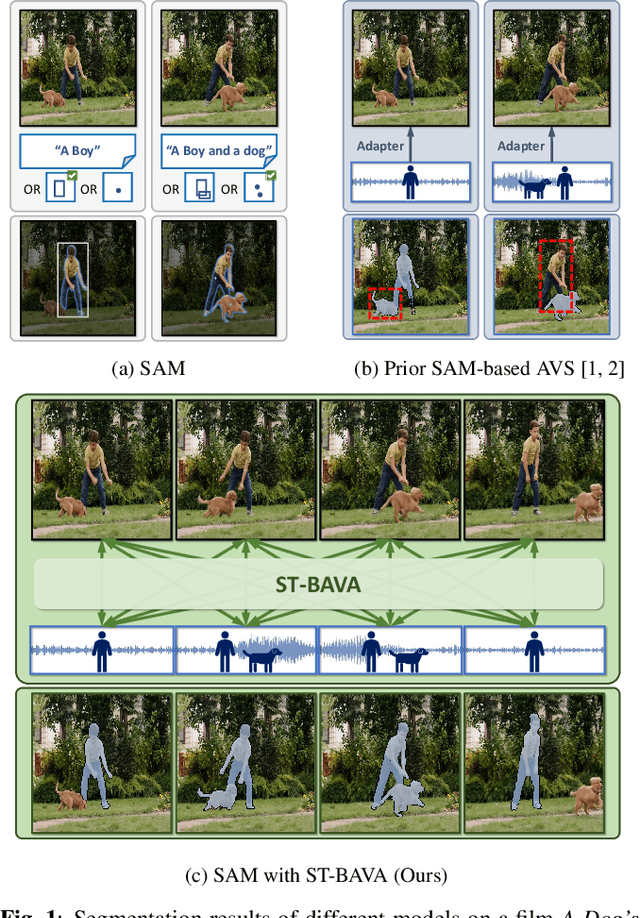
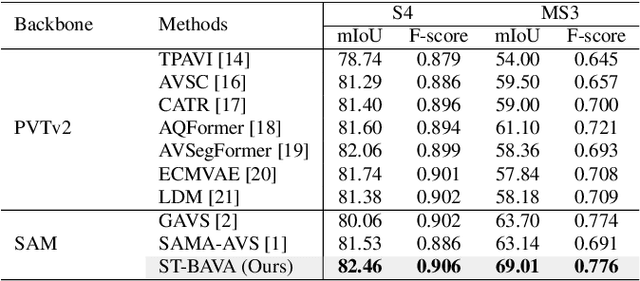
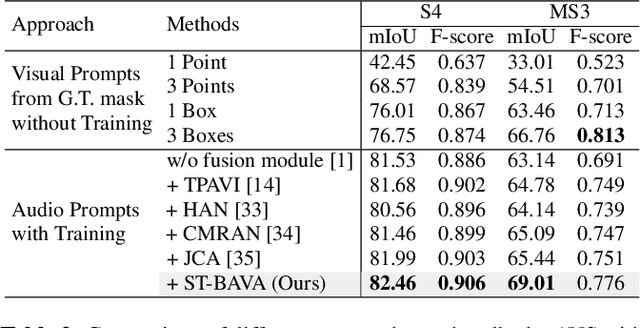
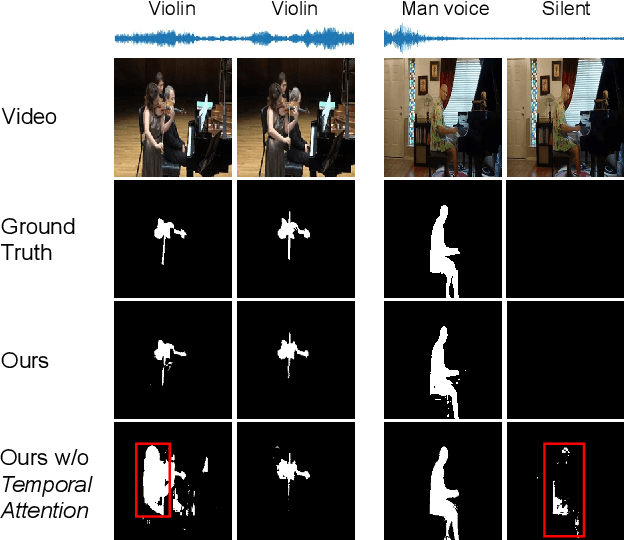
Abstract:Audio-visual segmentation (AVS) aims to segment sound sources in the video sequence, requiring a pixel-level understanding of audio-visual correspondence. As the Segment Anything Model (SAM) has strongly impacted extensive fields of dense prediction problems, prior works have investigated the introduction of SAM into AVS with audio as a new modality of the prompt. Nevertheless, constrained by SAM's single-frame segmentation scheme, the temporal context across multiple frames of audio-visual data remains insufficiently utilized. To this end, we study the extension of SAM's capabilities to the sequence of audio-visual scenes by analyzing contextual cross-modal relationships across the frames. To achieve this, we propose a Spatio-Temporal, Bidirectional Audio-Visual Attention (ST-BAVA) module integrated into the middle of SAM's image encoder and mask decoder. It adaptively updates the audio-visual features to convey the spatio-temporal correspondence between the video frames and audio streams. Extensive experiments demonstrate that our proposed model outperforms the state-of-the-art methods on AVS benchmarks, especially with an 8.3% mIoU gain on a challenging multi-sources subset.
SemCity: Semantic Scene Generation with Triplane Diffusion
Mar 17, 2024



Abstract:We present "SemCity," a 3D diffusion model for semantic scene generation in real-world outdoor environments. Most 3D diffusion models focus on generating a single object, synthetic indoor scenes, or synthetic outdoor scenes, while the generation of real-world outdoor scenes is rarely addressed. In this paper, we concentrate on generating a real-outdoor scene through learning a diffusion model on a real-world outdoor dataset. In contrast to synthetic data, real-outdoor datasets often contain more empty spaces due to sensor limitations, causing challenges in learning real-outdoor distributions. To address this issue, we exploit a triplane representation as a proxy form of scene distributions to be learned by our diffusion model. Furthermore, we propose a triplane manipulation that integrates seamlessly with our triplane diffusion model. The manipulation improves our diffusion model's applicability in a variety of downstream tasks related to outdoor scene generation such as scene inpainting, scene outpainting, and semantic scene completion refinements. In experimental results, we demonstrate that our triplane diffusion model shows meaningful generation results compared with existing work in a real-outdoor dataset, SemanticKITTI. We also show our triplane manipulation facilitates seamlessly adding, removing, or modifying objects within a scene. Further, it also enables the expansion of scenes toward a city-level scale. Finally, we evaluate our method on semantic scene completion refinements where our diffusion model enhances predictions of semantic scene completion networks by learning scene distribution. Our code is available at https://github.com/zoomin-lee/SemCity.
Deep Video Inpainting Guided by Audio-Visual Self-Supervision
Oct 11, 2023Abstract:Humans can easily imagine a scene from auditory information based on their prior knowledge of audio-visual events. In this paper, we mimic this innate human ability in deep learning models to improve the quality of video inpainting. To implement the prior knowledge, we first train the audio-visual network, which learns the correspondence between auditory and visual information. Then, the audio-visual network is employed as a guider that conveys the prior knowledge of audio-visual correspondence to the video inpainting network. This prior knowledge is transferred through our proposed two novel losses: audio-visual attention loss and audio-visual pseudo-class consistency loss. These two losses further improve the performance of the video inpainting by encouraging the inpainting result to have a high correspondence to its synchronized audio. Experimental results demonstrate that our proposed method can restore a wider domain of video scenes and is particularly effective when the sounding object in the scene is partially blinded.
 Add to Chrome
Add to Chrome Add to Firefox
Add to Firefox Add to Edge
Add to Edge